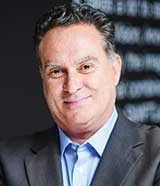Finastra launched its FusionFabric.cloud platform at the end of May to simplify app development for fintechs and help banks to find the right tech partner quickly.
The cloud-based platform site brings together developers in a way that makes it easier for banks to pick fintechs that provide the services closest to their needs, or to work with on developing something new.
Eli Rosner, chief product and technology officer at Finastra, says: “FusionFabric.cloud will change how financial institutions deploy their services. There has been a pace of rapid development already from the interest that has been shown.”
The platform had been in development for some time before its launch to ensure it had a good service offering from multiple fintechs.
 |
| Eli Rosner, Finastra |
Rosner says: “So far we have signed up 60 fintechs, who provide a range of services the banks need to create a high-quality offering. There has been a focus on bringing on board different fintechs. The goal is to create an ecosystem of banks, fintechs, universities and more.” Finastra has been selective in considering how the services of fintechs it chooses to on-board will be used, says Rosner, by looking for value-add fintechs that will create a new way of working, sometimes by combining products together.
“In the selection process we look at the breadth of the service that the fintechs are offering and ask how this can be leveraged,” he says.
“We did not want to just offer a selection of common banking services. There is the risk of the system becoming a commodity. Instead we looked at unbundling services and offering them so mashed apps can be developed.”
Finastra is applying rigorous controls to development, leading to a certification system for apps.
Rosner says: “The platform is open to all, but there is always a process to scrutinise each fintech first before selection. We certify the apps for quality, performance and user experience.”
Finastra’s control over development can extend into the app itself, making sure it meets the specifications set by customers.
Rosner says: “We have given the end-users the ability to access the software beta enabler to understand the business model and give us feedback on where the service needs to be improved.”
The company is confident that the platform will be a success because it removes the leg-work of finding fintechs and acts as quality controller for clients.
“What we have created is an asset,” Rosner claims.
Not alone
Fabian Vandenreydt, executive chairman at B-Hive, says the company has been considering how it can help fintechs work together, especially when regulators seem inclined to start treating them more like banks.
This is change that has not gone unnoticed by the banks themselves.
Mike Reed, executive vice-president and managing director of Europe at BofA Merrill Lynch Merchant Services, says the arrival of open banking through the second Payment Services Directive (PSD2) has created a playing field accessible to all.
“PSD2 has opened up what was exclusively the world of banking to the fintechs,” he says. “The regulations seen in Europe in particular are really assisting this advancement.”
The directive has forced fintechs to rethink how they are positioned.
“Open banking has brought the banking and tech providers together on one platform, and this has changed how they are thinking
 |
|
Fabian Vandenreydt,
B-Hive
|
about each other,” says Vandenreydt. “There is also a need to collaborate with governments and academics to bring knowledge and legitimacy to what is being developed.” One of the problems the fintechs want to avoid is being pushed by regulations into the same siloes as banks have been.
B-Hive noticed that different fintech hubs were taking different approaches to regulation and saw a risk of future fragmentation across working processes and geographies. The firm thinks this would weaken the industry.
“Fintech needs to be careful not to replicate the siloes seen in banking, but only in a modern way,” Vandenreydt says. “There needs to be understanding between fintech and regtech, and how they can work in tandem; and we also see room for growth and newer entrants like insurtech.
“In Europe we are working with fintech hubs in different cities to create links and partnerships. Fintechs are getting good at setting up operations together.”
Sharing developments could help to accelerate the pace of progress elsewhere.
Says Vandenreydt: “It is a nice challenge to pull all of our operations together, as we have offices in the UK, New York City and Tel Aviv. In the US, we are seeing developments on artificial intelligence, and we are looking at how to bring in these developments in line.”
Closer working should support companies as they develop and increase in scale; particularly in what is still an emerging industry.
Vandenreydt says: “B-Hive is only a year old, and in that time we have really had to learn how to scale. We work to support our clients in their digital transformation journey.”